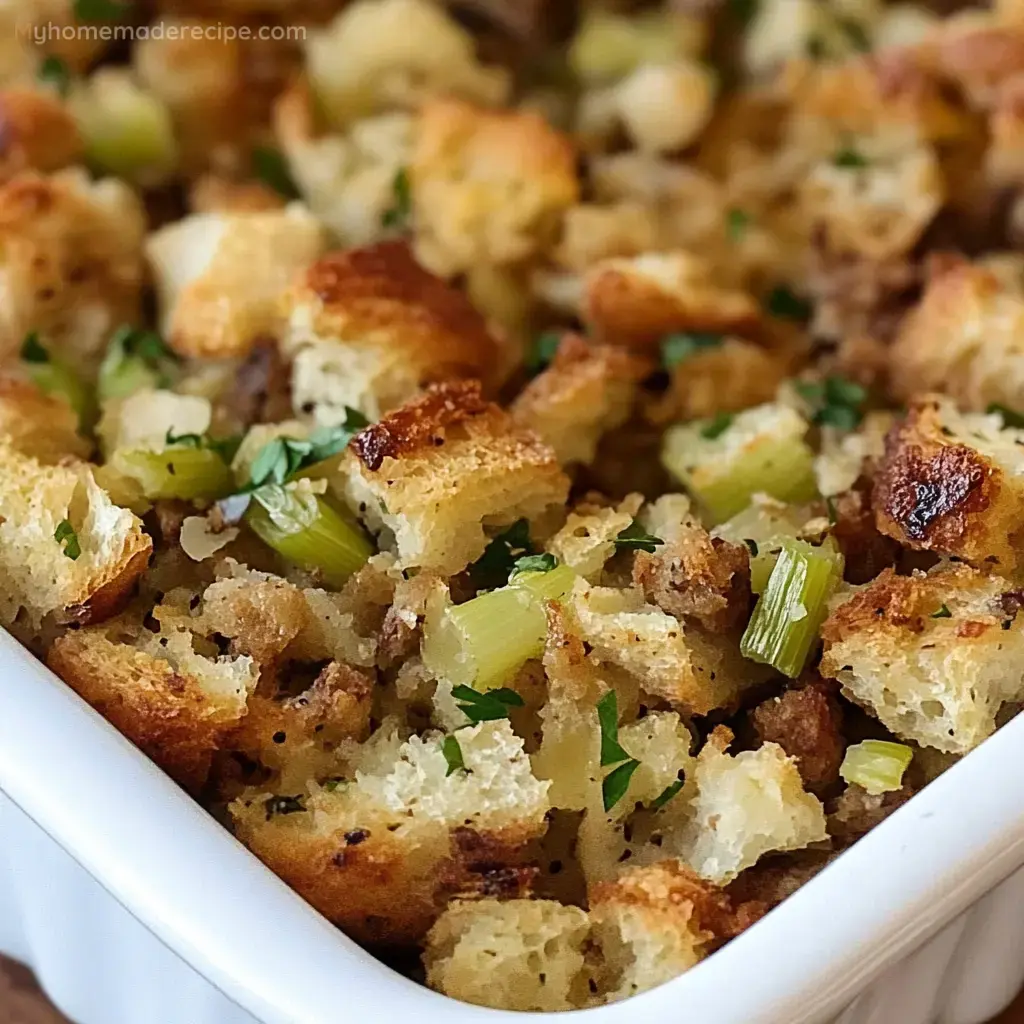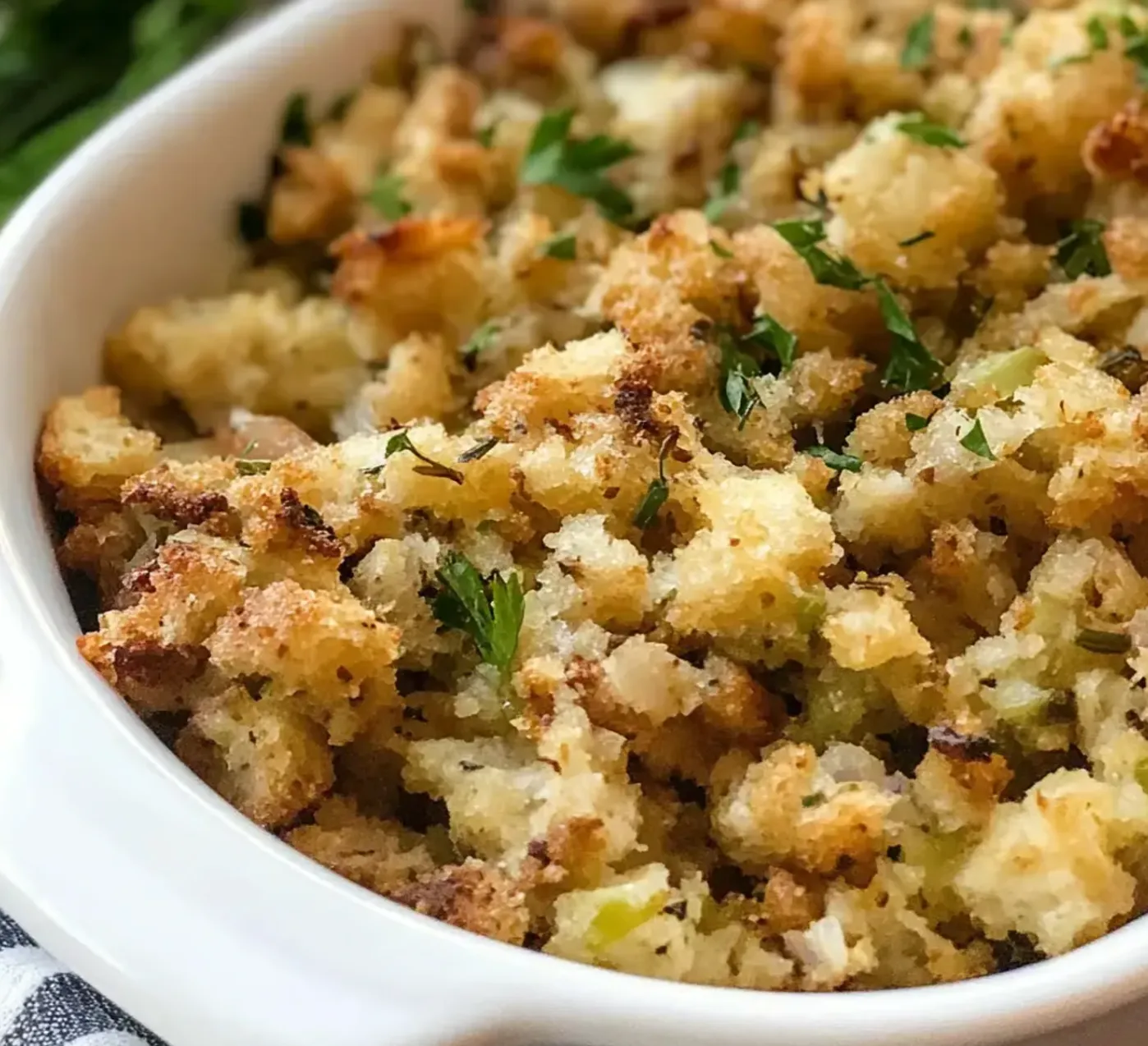 Pin it
Pin it
The comforting aroma of butter-soaked bread, fragrant herbs, and sautéed vegetables fills my kitchen each November as I prepare our cherished family stuffing recipe. This heart-warming dish, passed down from my grandmother, transforms simple ingredients into a masterpiece that has graced our Thanksgiving table for generations. The magic lies in allowing the bread to fully absorb the rich flavors of herbs and broth, creating perfectly crispy edges while maintaining a moist, tender center.
Last week, I made this stuffing for an early Thanksgiving gathering and my kitchen was filled with eager taste-testers. My youngest couldn't resist stealing crispy bits from the corner of the baking dish, while my mother-in-law asked for the recipe - a true victory!
Essential Ingredients and Selection Tips
- Bread Mix (French, sourdough, wheat): Choose bakery-fresh loaves and let them dry overnight. The mix of textures is our secret to perfect stuffing
- Yellow Onions: Pick firm onions with shiny, crackly skin - they'll have the sweetest flavor when sautéed
- Celery: Select bright green stalks with crisp leaves, indicating peak freshness for the best aromatic base
- Fresh Herbs (sage, thyme, parsley): Dark green, perky leaves mean maximum flavor. Avoid wilted or yellowing herbs
- Unsalted Butter: Splurge on European-style butter with higher fat content for unmatched richness
- Quality Chicken Stock: Homemade is best, but if using store-bought, choose low-sodium to control seasoning
Detailed Cooking Instructions
- Step 1: Bread Preparation (Day Before)
- Cut bread into 1-inch cubes, spread on baking sheets. Leave out overnight, stirring occasionally to ensure even drying. The cubes should feel dry but not rock-hard.
- Step 2: Aromatics Base (Day Of)
- Melt butter in a large skillet over medium heat until foamy. Add diced onions and celery, cooking slowly for 12-15 minutes. Keep stirring occasionally until vegetables are completely soft and translucent. Season with salt and pepper, letting the flavors develop.
- Step 3: Herb Integration
- Add fresh chopped herbs to the vegetable mixture. Cook for another 2-3 minutes to release essential oils. The kitchen should be filled with an intoxicating aroma. Remove from heat and let cool slightly.
- Step 4: Assembly
- Place dried bread cubes in your largest mixing bowl. Pour warm vegetable-herb mixture over bread. Toss gently but thoroughly with wooden spoons. Gradually add warm stock, letting bread absorb liquid between additions. Keep mixing until bread is evenly moistened but not soggy.
- Step 5: Baking Process
- Transfer to buttered baking dish, keeping mixture loose. Cover with foil, ensuring it's not pressed against the stuffing. Bake at 350°F for 30 minutes covered. Remove foil and bake additional 20-30 minutes until golden. Let rest 10 minutes before serving.
I've learned through years of making this recipe that sage is truly the star ingredient. My grandmother always grew her own sage plants, and I've continued this tradition. The silvery-green leaves from my garden add a depth that store-bought sage simply can't match. Just last month, my neighbor started growing sage after tasting this stuffing at our fall gathering.
The Art of Moisture Balance
Achieving the perfect moisture level in stuffing is like conducting a delicate orchestra. Too much liquid creates a soggy mess, while too little leaves you with dry, bread-cube stuffing. I've found that adding stock gradually while gently tossing the mixture gives bread cubes time to absorb liquid evenly. Watch for the moment when the bread squares feel moist but still hold their shape when gently squeezed.
Make-Ahead Magic
The beauty of this recipe lies in its flexibility for busy holiday schedules. I often prepare the dried bread cubes up to three days ahead, storing them in paper bags. The vegetable-herb mixture can be made a day in advance and refrigerated. Just warm it slightly before combining with the bread. This advance prep has saved my sanity during many holiday gatherings.
Family Memories in Every Bite
Each time I make this stuffing, I remember standing in my grandmother's kitchen, watching her expertly mix the ingredients without measuring. She taught me to trust my instincts - to feel the right moisture level and smell when the herbs had bloomed perfectly in the butter. Now my own children help me make it, continuing our family's tradition of cooking with love and intuition.
Storage and Leftovers
In our house, leftover stuffing is almost as coveted as the fresh-from-the-oven version. Store it covered in the refrigerator for up to four days. To reheat, sprinkle with a few drops of stock and cover with foil before warming in a 325°F oven. The best part? The edges get even crispier the second time around.
 Pin it
Pin it
This stuffing recipe represents everything I love about cooking - simple ingredients transformed by technique and time into something extraordinary. While I've made countless variations over the years, this version remains my gold standard for Thanksgiving stuffing. The way it brings together crusty edges, tender middle, and perfect seasoning makes it more than just a side dish - it's the heart of our holiday table.
